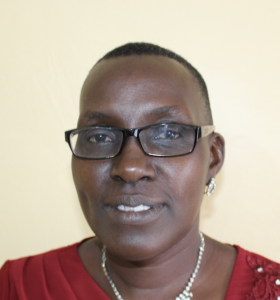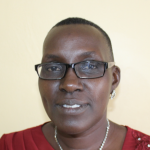It was a bright morning and it felt like the sun was up earlier than usual, causing temperatures to soar high. Thankfully there was a cool breeze that made it a bit more bearable walking under the sun.
Mukangu Primary School is situated in a rural area dotted with mud-walled houses and a few grass-thatched houses. The area is serene and peaceful but the busy road passing by the school creates a bit of background noise. The community obviously practices agriculture, since plantations fill the area between homes.
Mukangu Primary School began in 2014 with an early education department functioning in one single classroom made of mud. It is now operating as a full school from early education to class eight. They now have six mud classrooms and three cement structures, all filled by 360 students and 12 staff.
A normal day for pupils begins at 6am in the morning when they wake up to get ready for school. They are expected to arrive before 7am with their books and a 5-liter jerrycan full of water. They do cleaning work for 30 minutes and then assemble with the others to go to a well with a hatch to fetch more water, since 5 liters per student does not last very long. The lessons begin at 8am and run until students are released to return home for lunch at 12:30pm. Afternoon lessons go until 3pm and then students stay on the grounds for one hour of games before the final school bell rings.
Students stuffer from typhoid and must stay home from school. If a student gets sick several times, it's more likely that they drop out and stay home altogether. The cost of treating waterborne diseases is usually too high for the students' families, which causes them to cut on other expenses, of which school fees is the first line.
These typhoid cases are caused by drinking dirty water. The water students carry to school comes from various sources, many of which are not clean. Some even arrive with water in various shades of brown. The water students get from the well with a hatch is also dirty. The water looks clean at first, but upon closer inspection you can see tiny living organisms moving around in the water.
Students dread walking to that well. They have to leave school and walk through sugarcane plantations, where they often encounter snakes. Being used by many members of the community, the water in the well is not sufficient and sometimes gets depleted and must be allowed a few days to recharge. The owner of the well also locks the hatch at random times, so students could walk all the way out there and not be able to return to school with any water.
The well has a 10-liter container tied to a rope that is used lowered through the hatch to collect water. Students use that container to refill the 5-liter containers they brought from home. Most of them do not have covers since the pupils lose them on the way to school or when playing with them. Not all of the containers are clean, as you can see dark markings inside.
The deputy headteacher himself often avoids the water that students gather. "The idea of having to send a student to get you drinking water is not good. Some of us are forced to walk home to get water so that you can ascertain it is safe for drinking. Some of these pupils fetch the water and dip their fingers in it, how can you drink that water?" Mr. Mahulo reflected.
What we can do:
"The condition of hygiene in the school is very pathetic. First, the toilets are not enough because the boys have only two doors which they share with the [neighboring] church. They are almost full and the sanitation condition is very poor. The toilets are cleaned twice a week due to the scarcity of water and the urinal is very dirty and all wet with urine," described Headteacher Shikoro.
"The containers which are used to carry water to school are also very dirty, which causes a lot of hygiene-related diseases."
Training
Training on good hygiene habits will be held for two days. The facilitator will use PHAST (participatory hygiene and sanitation transformation), ABCD (asset-based community development), CTC (child to child), lectures, group discussions, and handouts to teach health topics and ways to promote good practices within the school. The CTC method will prepare students to lead other students into healthy habits, as well as kickstart a CTC club for the school.
Handwashing Stations
There is nowhere to wash hands, nor would there be enough water to do so.
This CTC club will oversee the new facilities, such as handwashing stations, and make sure they are kept clean and in working condition. The two handwashing stations will be delivered to the school, and the club will fill them with water on a daily basis and make sure there is always a cleaning agent such as soap or ash.
VIP Latrines
The boys' toilets are almost full, they're filthy because there isn't enough water, and some lack doors. The girls' toilets are stable but the sanitation conditions are pathetic. The school told us that they normally wash the toilets twice a week, on Mondays and Wednesdays, because they do not have sufficient water to wash the toilets every day.
Two triple-door latrines will be constructed with local materials that the school will help gather. Three doors will serve the girls while the other three serve the boys. And with a new source of water on school grounds, students and staff should have enough to keep these new latrines clean.
Rainwater Catchment Tank
A 50,000-liter rainwater catchment tank will help alleviate the water crisis at this school. The school will also help gather the needed materials such as sand, rocks, and water for mixing cement. Once finished, this tank can begin catching rainfall that will be used by the school’s students and staff.
This being a rainy region, a rainwater catchment tank is a great solution. Students will no longer carry heavy containers of water from unknown sources or leave school to get more water throughout the day.

 Rainwater Catchment
Rainwater Catchment
 Rehabilitation Project
Rehabilitation Project



































